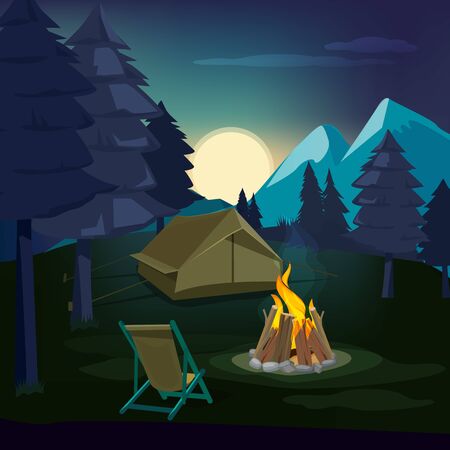Introduction: Embracing Roman Heritage under Canvas
Camping amidst the evocative remains of Roman Britain is more than just a getaway—its an immersive journey through time. For those seeking to connect with the UKs ancient past while enjoying the freedom of the great outdoors, pitching your tent near centuries-old ruins offers a truly unique experience. Imagine waking up to birdsong, with mist curling over half-buried stone walls and the faint outline of a Roman fort visible in the morning light. This blend of history and nature is distinctively British: winding footpaths through wildflower meadows lead to crumbling amphitheatres, bathhouses, or stretches of Hadrian’s Wall, all set against some of the country’s most unspoilt landscapes. Unlike traditional sightseeing, camping gives you time to soak up the atmosphere at your own pace—whether that means exploring archaeological sites before breakfast or stargazing beside ancient ramparts after dark. For families, history buffs, or anyone craving something out of the ordinary, these sites offer a practical and adventurous base for discovering Britain’s rich Roman heritage right from your sleeping bag.
2. Essential Gear and Tips for Roman Ruin Camping
Planning a camping trip amidst Britain’s ancient Roman ruins is not just about picking the right spot—it’s also about being well-prepared, respecting local customs, and ensuring your adventure leaves no trace. Here’s your practical guide to what to pack, British camping etiquette, and key tips for making the most of your historical outdoor stay.
Packing Essentials for a British Roman Ruin Adventure
| Item | Why You Need It | Local Tip |
|---|---|---|
| All-Weather Tent | Bristol drizzle or Scottish winds—British weather is famously unpredictable. | Choose a tent with strong pegs for rocky ground near ruins. |
| Quality Sleeping Bag & Mat | Nights can be chilly even in summer; comfort is key after a day of exploring ruins. | Opt for a four-season bag if heading north. |
| Sturdy Walking Boots | Roman sites often mean uneven terrain and muddy paths. | Waterproof boots save the day in soggy fields. |
| Reusable Water Bottle & Food Containers | Minimise waste—many ruin sites are remote with limited facilities. | Pack out all rubbish to respect these precious sites. |
| Torch/Headlamp (with spare batteries) | No light pollution here—pitch black after sunset! | A red light setting preserves night vision and disturbs less wildlife. |
| Heritage-Friendly Cleaning Supplies | No harsh chemicals near ancient stones! | Use eco-friendly soap and wipes only. |
| Packed Guidebook or Offline Map App | Signal can be patchy; know where you’re headed and what you’re seeing. | The Ordnance Survey app is a local favourite. |
Campsite Etiquette: The British Way
- Quiet Hours: Most rural campsites expect peace after 10pm—keep music and chatter low to let everyone soak up the historic atmosphere.
- Pitches Matter: Only set up camp in designated areas, never on or immediately beside ruins. This protects both the site and your safety.
- No Fires on the Ground: Open fires are usually banned near heritage sites; always use raised stoves or BBQs provided by the campsite, and double-check local rules first.
Respecting Heritage Sites: Leave No Trace Principles
- No Climbing on Ruins: Ancient walls may look sturdy but are easily damaged—admire, don’t touch!
- No Wild Camping at Scheduled Monuments: In England and Wales, wild camping is rarely permitted without landowner permission. Scotland has more relaxed rules but always check access rights beforehand.
- Take Only Photos: Removing even small stones or artefacts is illegal and disrespectful to Britain’s shared history.
Must-Know Comfort Tips for British Camping
- Packing Layers: British weather can go from sunny to stormy in minutes. Layer up!
- Midge Defence: If heading to Hadrian’s Wall or other northern sites in summer, bring repellent—midges love campers as much as Romans did their forts!
- Cuppa Essentials: A proper brew kit (kettle, tea bags, flask) is almost obligatory—nothing beats warming up with a cup of tea overlooking a Roman amphitheatre at dawn.
With these essentials packed and local customs in mind, your camping trip among Roman ruins will be comfortable, respectful, and truly unforgettable—the perfect blend of British practicality and historical adventure.

3. Hadrian’s Wall: Wild Camping Along the Northern Frontier
If you’re keen to truly immerse yourself in Britain’s Roman past, wild camping along Hadrian’s Wall is a must-do adventure. Stretching 73 miles across northern England from Wallsend to Bowness-on-Solway, this UNESCO World Heritage Site offers both iconic and hidden gems for history buffs and campers alike.
Iconic Sites to Pitch Your Tent
The central section of Hadrian’s Wall, particularly near Housesteads and Steel Rigg, is where the Roman remains are at their most dramatic. Here, the wall snakes along rugged crags with panoramic views over Northumberland National Park. The area around Sycamore Gap—made famous by the ‘Robin Hood: Prince of Thieves’ film—is especially popular with campers seeking a scenic sunrise or sunset. These locations provide not just a visual feast but also an atmospheric backdrop for your overnight stay.
Lesser-Known Spots Worth Discovering
For those who prefer quieter spots, try heading west towards Birdoswald or east near Chollerford. The landscapes here are more gentle, dotted with small forts and milecastles that see fewer tourists. While it’s essential to respect private land and local regulations (wild camping isn’t strictly legal in England, so always seek landowner permission), these areas often offer a sense of solitude rarely found elsewhere on the trail.
Practical Tips for Camping Along the Wall
The weather along Hadrian’s Wall can be unpredictable, so pack sturdy gear and waterproofs. Water sources are sparse on some stretches, so plan ahead or fill up at local pubs and visitor centres (many are welcoming to hikers). Mobile reception can be patchy; having an OS map or GPS is highly recommended. Don’t forget to leave no trace—take all rubbish with you and avoid lighting open fires.
Local villages like Haltwhistle and Gilsland are handy for supplies and a warm meal after a night under canvas. For an extra treat, pop into one of the friendly country pubs for a pint of local ale—you’ll find British hospitality alive and well in these rural communities.
4. Bath and the Cotswolds: Roman Baths to Idyllic Campsites
For campers seeking a perfect fusion of history, relaxation, and countryside charm, few places rival the combination of Bath and the Cotswolds. Here, you can wander among ancient Roman baths by day and retire to tranquil sites surrounded by rolling English hills come nightfall. Let’s dive into how you can blend Roman-era explorations with classic camping experiences in this iconic region.
Exploring Bath’s Roman Legacy
The city of Bath is famed for its exceptionally well-preserved Roman Baths—a must-see for any traveller interested in ancient Britain. Wander through the original Great Bath, marvel at intricate mosaics, and soak up stories of how Romans once unwound in these thermal waters. Don’t forget to stroll the Georgian streets afterwards, where history seems to echo from every limestone facade.
Must-Visit Roman Ruins in the Area
| Site | Description | Travel Tip |
|---|---|---|
| Roman Baths (Bath) | A world-class archaeological site with interactive exhibits and guided tours. | Book tickets online to avoid queues, especially during summer holidays. |
| Chedworth Roman Villa | Nestled in the Cotswold hills, this villa boasts impressive mosaics and bathhouse remains. | Bring sturdy walking shoes for exploring woodland trails around the villa. |
Top-Rated Campsites Near Ancient Wonders
Pitching your tent or parking your campervan near these historic sites gives you a unique sunrise-to-sunset experience of Britain’s rural splendour. Here are some highly rated campsites that offer both comfort and proximity to Roman heritage:
| Campsite Name | Location | Key Features |
|---|---|---|
| Bath Chew Valley Caravan Park | Chew Magna, near Bath | Adults-only, peaceful setting, easy access to Bath city centre and Mendip Hills. |
| Briarfields Touring Park | Cheltenham (Cotswolds edge) | Excellent facilities, close to Chedworth Roman Villa and Cotswold market towns. |
| The Wildings Campsite | Bourton-on-the-Water | Family-friendly, fire pits allowed, within striking distance of Cotswold attractions. |
A Proper British Camping Experience
No British camping adventure is complete without a hearty pub meal or an evening stroll through meadows laced with wildflowers. The villages surrounding Bath and the Cotswolds brim with welcoming inns where you can sample local ales after a day spent exploring ancient ruins. Remember to pack a raincoat—it wouldn’t be a true UK getaway without a spot of unpredictable weather!
Practical Tips for Campers
- Check campsite booking requirements ahead of time—summer weekends fill up fast.
- If travelling by public transport, look for bus routes connecting Bath with key Roman sites in the Cotswolds.
- Some campsites offer glamping pods for those who fancy a little extra comfort after a day on their feet.
- Respect local wildlife and leave no trace to help keep these idyllic landscapes pristine for future explorers.
The blend of awe-inspiring Roman history with the timeless beauty of England’s countryside makes camping in Bath and the Cotswolds an unmissable chapter in your journey through ancient Britain.
5. The Southern Coast: Roman Villas and Seaside Escapes
If you’re after a unique blend of history, nature, and that unmistakable bracing sea air, the southern coast of England is an absolute must for your Roman-themed camping adventure. This stretch is renowned not only for its dramatic cliffs and sweeping beaches but also for its remarkable Roman heritage—none more impressive than the famed Fishbourne Roman Palace. As the largest Roman residential building unearthed in Britain, Fishbourne offers a glimpse into the opulent lifestyles of ancient aristocrats, with intricate mosaics and lush reconstructed gardens that are simply jaw-dropping.
Clifftop Camping: Views with a Story
Several well-kept campsites dot the coastline from Chichester to Brighton, offering pitches with front-row seats to panoramic sea views and easy access to local Roman sites. Imagine waking up to the sound of gulls, spending your morning wandering among centuries-old villa remains, then returning to your tent or campervan for a classic British cuppa as the sun sets over the Channel.
Top Picks: Where History Meets the Horizon
- Fishbourne Campsite: Only a stone’s throw from the palace itself, this site provides both grassy tent spots and hard-standing pitches. It’s ideal for families and solo explorers alike.
- Seaford Head: Perched atop chalky cliffs, this spot puts you within easy striking distance of not just Fishbourne but also the South Downs Way—a perfect combo of Roman history walks and windswept coastal rambles.
Practical Tips & Local Flavour
Don’t forget to pack sturdy boots—the terrain can be rugged, especially if you’re venturing down to hidden coves or tackling the coastal paths. Many campsites are dog-friendly, so feel free to bring along your four-legged companion for those long beach strolls. And after a day exploring ancient mosaic floors or tracing lost Roman roads, treat yourself to some proper fish and chips at a local chippy—nothing says British seaside quite like it!
The southern coast seamlessly weaves together striking natural beauty with echoes of Britannia’s distant past. For campers keen on mixing historical intrigue with fresh sea breezes, there are few better places to pitch up and soak in ancient Britain’s enduring charm.
6. Practical Experiences: Campfire Cooking and Local Finds
There’s something undeniably magical about cooking over an open flame with the silhouettes of ancient Roman ruins nearby. Over the years, my camping trips across Britain have taught me that a campfire isn’t just for warmth—it’s the heart of your outdoor kitchen and a bridge to both history and local culture. For starters, nothing beats waking up to a classic British bacon sarnie crisped up in a cast-iron pan, the aroma mingling with the morning mist as it curls through crumbled stone arches.
When pitching up near sites like Hadrian’s Wall or Caerleon, I always make it a point to scout out local markets before settling in for the night. There’s usually a wealth of fresh produce: think wild mushrooms from Northumberland, Welsh lamb sausages, or even locally-made cheddar—perfect for topping a baked potato straight from the embers. My personal tip? Wrap root vegetables in foil and nestle them in the fire while you explore; they’ll be soft and smoky by supper time.
No British camping experience is complete without a good brew. While the Romans favoured their wine, we Brits have our own traditions. I love making tea on the camp stove at dusk, using water drawn from a nearby stream (filtered, of course), and pairing it with crumbly oatcakes or a slice of bara brith if I’m in Wales. And if you fancy something stronger, track down a bottle of local ale—raise a toast to the legionnaires who might have done much the same two millennia ago.
In all these small rituals—sourcing ingredients from local farms, chatting with villagers about traditional recipes, or simply sitting by the fire under starlit skies—you’ll find that camping amidst Roman ruins becomes more than just a getaway. It’s an immersion into Britain’s living history, one hearty meal at a time.
7. Respecting Ancient Britain: Responsible and Legal Camping
Camping near Roman ruins is a truly unique way to immerse yourself in Britain’s ancient heritage, but it comes with important responsibilities. Understanding local laws and practising respect for the sites ensures these historic treasures remain unspoilt for generations.
Camping Laws Across the UK
England & Wales
Wild camping is generally not permitted without the landowner’s permission in England and Wales. While there are some exceptions—such as certain areas of Dartmoor National Park—most Roman ruins sit on private or protected land. Always check official guidance and seek explicit consent before setting up camp near any archaeological site.
Scotland
Scotland offers more freedom through its “right to roam” under the Land Reform (Scotland) Act 2003, allowing wild camping on most unenclosed land. However, this right comes with the responsibility to follow the Scottish Outdoor Access Code. When exploring Roman forts like those along Hadrian’s Wall or Antonine Wall, pay attention to any local restrictions and signage, especially in sensitive conservation areas.
Leave No Trace Principles
Preserving the integrity of ancient sites is crucial. Always use established paths, avoid disturbing ruins or artefacts, and never remove stones or relics. Dispose of all rubbish responsibly, use biodegradable products, and avoid open fires unless in designated spots. Portable stoves are a safer alternative around fragile remains.
Respectful Behaviour at Historic Sites
- Keep noise levels down to maintain the tranquillity of these locations.
- Refrain from climbing on walls or monuments.
- If you’re travelling with pets, ensure they do not disturb wildlife or livestock.
A Legacy for Future Generations
Cherishing Britain’s Roman legacy means enjoying these sites responsibly. By following local laws and leaving no trace, you’ll help protect these ancient wonders so others can experience their magic too—just as you have.


